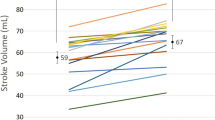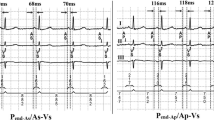Abstract
Introduction
Unnecessary ventricular pacing is associated with increased morbidity and mortality. Over the years different algorithms have been developed to reduce right ventricular pacing.
Objectives
Goal of the present study was to test the efficacy of the ventricular intrinsic preference (VIP) algorithm in patients with atrioventricular intact (AVi) and atrioventricular compromised (AVc) AV-conduction.
Methods
Evaluation of VIP feature in pacemaker patients (EVITA) was a multicenter, prospective, randomized trial (Trials.gov Identifier: NCT00366158). In total, 389 patients were randomized to AVc group: n = 140/132 VIP OFF/VIP On, AVi group: n = 54/63 VIP OFF/VIP ON). One-month post-implantation AV conduction testing (AVc: PR/AR interval > 210 ms) was performed. Follow-up visits occurred 6 and 12 months after DDD-pacemaker implantation.
Results
In AVi and AVc-patients initiation of the VIP feature significantly reduced incidence of ventricular pacing (AVi: 53 ± 38 vs. 9 ± 21 %, p = 0.0001; AVc: 79 ± 31 vs. 28 ± 35 %, p = 0.0001). DDD-pacemaker implantation per se significantly reduced incidence of AF in VIP ON (AVi 27 vs. 0 %, p < 0.0001; AVc 29 vs. 3 %, p < 0.0001) and VIP OFF patients (AVi 43 vs. 4 %, p < 0.0001; AVc 33 vs. 3 %, p < 0.0001), without significant differences between VIP ON and OFF groups (p > 0.05). In the AVc group activation of VIP significantly reduced incidence of adverse events (AE). All-cause mortality was not significantly different in VIP ON (n = 5) and VIP OFF (n = 4, p > 0.05) patients.
Conclusion
AV search hysteresis (VIP) markedly reduces ventricular pacing both in patients with normal AV conduction and in patients with prolonged PR interval or intermittent AV block.
Zusammenfassung
Hintergrund
Unnötige ventrikuläre Stimulation ist mit einer erhöhten Mortalität und Morbidität vergesellschaftet. In den vergangenen Jahren wurden verschiedene Algorithmen zur Reduktion der ventrikulären Stimulation entwickelt.
Fragestellung
Ziel der vorliegenden Studie war es, die Effektivität des VIP-Algorithmus bei Patienten mit intakter (AVi) und kompromittierter (AVc) atrioventrikulärer Leitung zu testen.
Material und Methoden
EVITA war eine prospektive und randomisierte Multicenterstudie (Trials.gov Identifier: NCT00366158). Insgesamt wurden 389 Patienten in eine AVc- (n = 140/132 VIP OFF/VIP On) oder AVi Gruppe (n = 54/63 VIP OFF/VIP ON) randomisiert. Einen Monat nach Implantation erfolgte eine Testung der AV-Knotenleitung(AVc: PR/AR-Intervall > 210 ms). Die Nachsorgen wurden 6 and 12 Monate nach DDD-Schrittmacherimplantation durchgeführt.
Ergebnisse
Bei AVi- and AVc-Patienten führte die Initiierung des VIP-Algorithmus zu einer signifikanten Reduktion ventrikulärer Stimulation (AVi: 53 ± 38 vs. 9 ± 21 %, p = 0,0001; AVc: 79 ± 31 vs. 28 ± 35 %, p = 0,0001). Die DDD-Schrittmacherimplantation per se sorgte für eine signifikanten Reduktion von Vorhofflimmern bei VIP ON- (AVi 27 vs. 0 %, p < 0,0001; AVc 29 vs. 3 % p < 0,0001) und VIP OFF-Patienten (AVi 43 vs. 4 %, p < 0,0001; AVc 33 vs. 3 %p < 0,0001), ohne signifikanten Unterschiede im direkten Vergleich der Gruppen (p > 0,05). In der AVc-Gruppe reduzierte die Aktivierung des VIP Algorithmus die Inzidenz von unerwarteten Ereignissensignifikant (AE). Die Gesamtmortalität war bei VIP ON (n = 5) und VIP OFF (n = 4,) Patienten nicht signifikant unterschiedlich (p > 0,05).
Schlußfolgerung
Die AV-Such-Hysterese (VIP) reduziert signifikant die ventrikuläre Stimulation bei Patienten mit normaler wie auch kompromittierter atrioventrikulärer Leitung.


Similar content being viewed by others
References
Andersen HR, Nielsen JC, Thomsen PE et al (1997) Long-term follow up of patients from a randomised trial of atrial versus ventricular pacing for sick sinus syndrome. Lancet 350:1210–1216
Sweeney MO, Bank AJ, Nsah E et al (2007) Minimizing ventricular pacing to reduce atrial fibrillation in sinus node disease. N Engl J Med 357:1000–1008
Andersen HR, Nielsen JC, Thomsen PEB et al (1998) Atrioventricular conduction during long-term-follow-up of patients with sick sinus syndrome. Circulation 98:1315–1321
Lamas GA, Lee KL, Sweeney MO et al (2002) Ventricular pacing or dual-chamber pacing for sinus-node dysfunction. N Engl J Med 346:1854–1862
Wilkoff BL, Cook JR, Epstein AE et al (2002) Dual-chamber pacing or ventricular backup pacing in patients with an implantable defibrillator: the Dual Chamber and VVI Implantable Defibrillator (DAVID) Trial. JAMA 288:3115–3123
Nielsen JC, Thomsen PE, Højberg S et al (2011) DANPACE Investigators. A comparison of single-lead atrial pacing with dual-chamber pacing in sick sinus syndrome. Eur Heart J 32(6):686–696
Pürerfellner H, Brandt J, Israel C et al (2008) Comparison of two strategies to reduce ventricular pacing in pacemaker patients. Pacing Clin Electrophysiol 31(2):167–176
Stierle U, Krüger D, Vincent AM et al (1998) An optimized AV delay algorithm for patients with intermittent atrioventricular conduction. Pacing Clin Electrophysiol 21(5):1035–1043
Kolb C, Schmidt R, Dietl JU et al (2011) PREVENT study group. Reduction of right ventricular pacing with advanced atrioventricular search hysteresis: results of the PREVENT study. Pacing Clin Electrophysiol 34:975–983
Gregoratos G, Abrams J, Epstein AE et al (2002) ACC/AHA/NASPE 2002 guideline update for implantation of cardiac pacemakers and antiarrhythmia devices: summary article: a report of the American College of Cardiology/American Heart Association Task Force on Practice Guidelines (ACC/AHA/NASPE Committee to Update the 1998 Pacemaker Guidelines). Circulation 106:2145–2161
Miyamoto M, Kimura Y, Hosoda J et al (2012) Does reducing unnecessary right ventricular pacing improve sympathetic activity and innervations of heart in sinus node disease patients? MVP and Safe R Study. Int Heart J 53:353–358
Murakami Y, Tsuboi N, Inden Y et al (2010) Difference in percentage of ventricular pacing between two algorithms for minimizing ventricular pacing: results of the IDEAL RVP (Identify the Best Algorithm for Reducing Unnecessary Right Ventricular Pacing) study. Europace 12:96–102 (25)
Boston Scientific corporation http://www.bostonscientific.com/en-US/products/pacemakers/altrua-pacemaker.html
Schuchert A, Kolb C, Hümmer A et al (2008) “Automatic AV hysteresis effectively reduces ventricular pacing in patients with sick sinus node and intermittent AV-Block” Europace 8(Suppl. 1):223/1
Israel-CW (2011) Prevention of atrial fibrillation by prevention of ventricular pacing? Europace 13:765–767
Wiggers C (1925) The muscular reactions of the mammalian ventricles to artificial surface stimuli. Am J Physiol 73:346–378
Prinzen FW (1999) Mapping of regional myocardial strain and work during ventricular pacing: experimental study using magnetic resonance imaging tagging. J Am Coll Cardiol 33:1735–1742
Veasey RA, Arya A, Silberbauer J et al (2011) The relationship between right ventricular pacing and atrial fibrillation burden and disease progression in patients with paroxysmal atrial fibrillation: the long-MinVPACE study. Europace 13:815–820
Thibault B, Simpson C, Gagné CE et al (2009) Impact of AV conduction disorders on SafeR mode performance. Pacing Clin Electrophysiol 32(Suppl 1):S231–S235
Silberbauer J, Veasey RA, Freemantle N et al (2009) The relationship between high-frequency right ventricular pacing and paroxysmal atrial fibrillation burden. Europace 11:1456–1461
McIntosh R, Veasey RA, Hong PSG et al (2008) The relationship between right ventricular pacing and atrial fibrillation burden in patients with paroxysmal atrial fibrilation. J Interv Card Electrophysiol 21:105
Milasinovic G, Sperzel J, Smith TW et al (2006) Reduction of RV pacing by continuous optimization of the AV interval. Pacing Clin Electrophysiol 29:406–412
Gillis AM, Purerfellner H, Israel CW et al (2006) Reducing unnecessary right ventricular pacing with the managed ventricular pacing mode in patients with sinus node disease and AV block. Pacing Clin Electrophysiol 29:697–705
Olshansky B, Day JD, Moore S et al (2007) Is dualchamber programming inferior to single-chamber programming in an implantable cardioverter-defibrillator? Results of the INTRINSIC RV (Inhibition of Unnecessary RV Pacing With AVSH in ICDs) study. Circulation 115:9–16
Sweeney MO, Ellenbogen KA, Casavant D et al (2005) Multicenter, prospective, randomized safety and efficacy study of a new atrial based managed ventricular pacing mode (MVP) in dual chamber ICDs. J Cardiovasc Electrophysiol 16:811–817
Milasinovic G, Tscheliessnigg K, Boehmer A et al (2008) Percent ventricular pacing with managed ventricular pacing mode in standard pacemaker population. Europace 10:151–155
Sweeney MO, Hellkamp AS, Ellenbogen KA et al (2003) Adverse effect of ventricular pacing on heart failure and atrial fibrillation among patients with normal baseline QRS duration in a clinical trial of pacemaker therapy for sinus node dysfunction. Circulation 107:2932–2937
Ishikawa T, Kimura K, Miyazaki N et al (1992) Diastolic mitral regurgitation in patients with first-degree atrioventricular block. Pacing Clin Electrophysiol 15:1927–1931 (26)
Gold MR, Adler S, Fauchier L et al (2009) SAFARI Investigators. Impact of atrial prevention pacing on atrial fibrillation burden: primary results of the Study of Atrial Fibrillation Reduction (SAFARI) trial. Heart Rhythm 6(3):295–301
Acknowledgment
This study was financially supported by St. Jude.
Author information
Authors and Affiliations
Corresponding author
Ethics declarations
Conflicts of interest
A. Bauer received speaker honorarium from Medtronic and St. Jude. C. Barr receives consulting fees from Cameron Health and fellowships funded by Biotronic, St. Jude and Medtronic. L.Toivonen, J. Voitk, and P. Peytchev declare that there are no conflicts of interest.
All procedures followed were in accordance with the ethical standards of the responsible committee on human experimentation (institutional and national) and with the Helsinki Declaration of 1975 (in its most recently amended version). Informed consent was obtained from all patients included in the study.
Rights and permissions
About this article
Cite this article
Bauer, A., Vermeulen, J., Toivonen, L. et al. Minimizing right ventricular pacing in pacemaker patients with intact and compromised atrioventricular conduction. Herzschr Elektrophys 26, 359–366 (2015). https://doi.org/10.1007/s00399-015-0394-2
Received:
Accepted:
Published:
Issue Date:
DOI: https://doi.org/10.1007/s00399-015-0394-2




